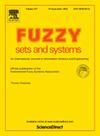Temporally adaptive hierarchical Choquet integrals: A measure-theoretic framework for dynamic non-additive integration in approximate reasoning
IF 2.7
1区 数学
Q2 COMPUTER SCIENCE, THEORY & METHODS
引用次数: 0
Abstract
This paper introduces the Temporally Adaptive Hierarchical Choquet Integral (TAHCI), a novel theoretical framework that extends classical Choquet integration to address temporal dynamics and high-dimensional data through hierarchical structures and time-evolving fuzzy measures. We develop a rigorous measure-theoretic foundation for this framework, including a complete axiomatic characterization, uniqueness results, and preservation properties. The proposed formulation overcomes theoretical limitations of traditional models by offering tractable parameterization (reducing complexity from to , where R is the tensor rank, n is the feature dimensionality, and d is the hierarchy depth) while preserving key measure-theoretic properties. We establish fundamental mathematical results including convergence rates, expressivity bounds, and stability under perturbations. Our theoretical analysis reveals several novel classes of non-additive measures with unique properties that emerge from the temporal adaptation process. We characterize TAHCI's well-defined fixed points and convergence behavior under various conditions. This work advances non-additive measure theory by providing a mathematically principled approach to integrating temporal dynamics with hierarchical measure structures, with direct implications for reasoning under uncertainty and imprecision.
时间自适应分层Choquet积分:近似推理中动态非加性积分的测度理论框架
本文介绍了时间自适应分层Choquet积分(TAHCI),这是一个新的理论框架,它扩展了经典的Choquet积分,通过分层结构和时间演化模糊度量来处理时间动态和高维数据。我们为这个框架建立了严格的测度理论基础,包括完整的公理化表征、唯一性结果和保存性质。提出的公式通过提供易于处理的参数化(将复杂度从O(2n)降低到O(Rnd),其中R为张量秩,n为特征维数,d为层次深度)克服了传统模型的理论局限性,同时保留了关键的度量理论性质。我们建立了基本的数学结果,包括收敛率,表达性界,以及在扰动下的稳定性。我们的理论分析揭示了从时间适应过程中出现的几种具有独特性质的新型非加性测量。我们描述了TAHCI在各种条件下定义良好的不动点和收敛性。这项工作通过提供一种数学原理方法来整合时间动力学与分层测量结构,从而推进了非加性测量理论,并直接影响了不确定性和不精确情况下的推理。
本文章由计算机程序翻译,如有差异,请以英文原文为准。
求助全文
约1分钟内获得全文
求助全文
来源期刊

Fuzzy Sets and Systems
数学-计算机:理论方法
CiteScore
6.50
自引率
17.90%
发文量
321
审稿时长
6.1 months
期刊介绍:
Since its launching in 1978, the journal Fuzzy Sets and Systems has been devoted to the international advancement of the theory and application of fuzzy sets and systems. The theory of fuzzy sets now encompasses a well organized corpus of basic notions including (and not restricted to) aggregation operations, a generalized theory of relations, specific measures of information content, a calculus of fuzzy numbers. Fuzzy sets are also the cornerstone of a non-additive uncertainty theory, namely possibility theory, and of a versatile tool for both linguistic and numerical modeling: fuzzy rule-based systems. Numerous works now combine fuzzy concepts with other scientific disciplines as well as modern technologies.
In mathematics fuzzy sets have triggered new research topics in connection with category theory, topology, algebra, analysis. Fuzzy sets are also part of a recent trend in the study of generalized measures and integrals, and are combined with statistical methods. Furthermore, fuzzy sets have strong logical underpinnings in the tradition of many-valued logics.
 求助内容:
求助内容: 应助结果提醒方式:
应助结果提醒方式:


